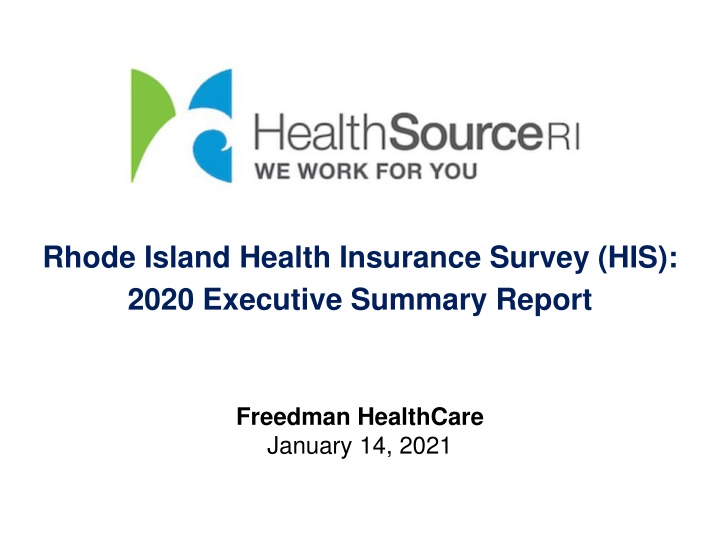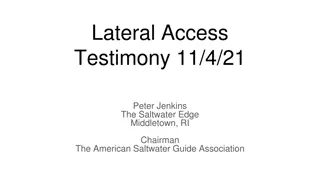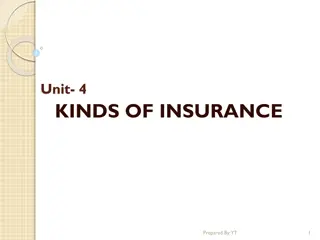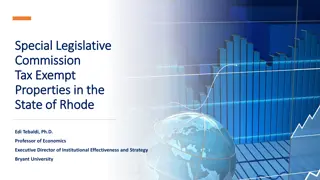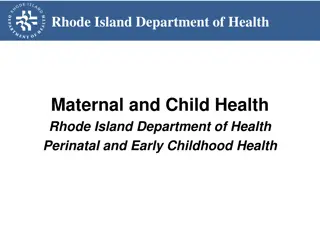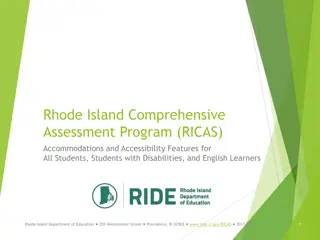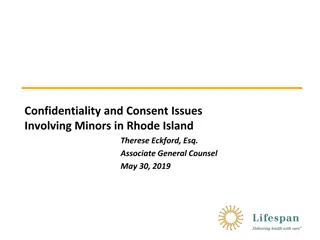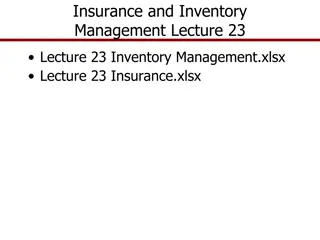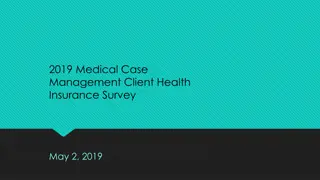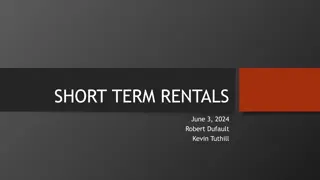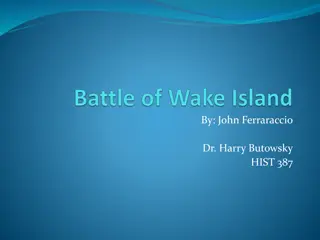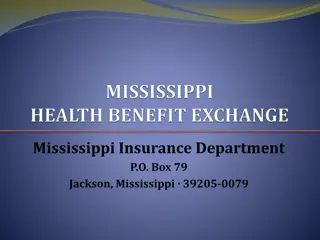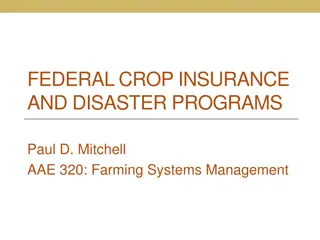Rhode Island Health Insurance Survey (HIS): 2020 Executive Summary Report
This executive summary report provides key findings from the Rhode Island Health Insurance Survey 2020, focusing on the uninsured population, underinsured population, Medicaid enrollment, and healthcare costs. Conducted by Freedman HealthCare, the survey gathers data on insurance status, healthcare expenses, access to care, and demographic variables of Rhode Islanders.
Download Presentation

Please find below an Image/Link to download the presentation.
The content on the website is provided AS IS for your information and personal use only. It may not be sold, licensed, or shared on other websites without obtaining consent from the author.If you encounter any issues during the download, it is possible that the publisher has removed the file from their server.
You are allowed to download the files provided on this website for personal or commercial use, subject to the condition that they are used lawfully. All files are the property of their respective owners.
The content on the website is provided AS IS for your information and personal use only. It may not be sold, licensed, or shared on other websites without obtaining consent from the author.
E N D
Presentation Transcript
Rhode Island Health Insurance Survey (HIS): 2020 Executive Summary Report Freedman HealthCare January 14, 2021
Table of Contents SECTION PAGE # 1. Introduction 1 2. Report Highlights 2 3. Demographic Overview 3 4. Coverage Trends 4 5. The Uninsured Population 5 6. State Mandate 18 7. The Underinsured Population 19 8. Cost of Care 24 9. Impact of Cost on Access 29 10. Glossary 30 11. Appendix 31
SECTION 1. Introduction The Rhode Island Health Information Survey (RI HIS) The RI HIS collects information on Rhode Islanders insurance status, healthcare costs, experience getting care, use of medical services, and relevant demographic variables. Five separate surveys were conducted via land-lines and cell phones between July and October 20121, March and June 2015, June and September 2016, June and December 2018, and April and September 2020.2 Surveys were conducted in English and Spanish. Market Decisions Research conducted the surveys on behalf of the Rhode Island Executive Office of Health and Human Services (EOHHS) and HealthSource RI (HSRI). Freedman HealthCare provided project management and analytic support. The respondent sample was drawn from RI residents, excluding those in institutional settings (e.g. jails and hospitals), group quarters (e.g. dormitories and military barracks), and non-permanent residences. In 2020, a total of 7,354 residents were interviewed from 3,000 households. Results were weight adjusted and normalized to the actual Rhode Island state population distribution using demographic information and population counts from the Census Bureau s American Community Survey, as well as plan enrollment and benefits data from HSRI.3 This Report The Executive Summary Report highlights key findings from the data regarding the uninsured population, the underinsured population, Medicaid and HSRI enrollment, and cost of care and access. Findings are based on data from the 2012, 2015, 2016, 2018, and 2020 surveys. Select demographic analyses are limited by the relative size, diversity, and populations of Rhode Island s counties. Some trend analyses are limited by the available years of data. The intent of this report is to guide dialogue on potential areas of future data and policy analyses. This report does not include operational and policy recommendations. 1 The first survey was conducted pre-Medicaid expansion. See Glossary for additional information on the impact of the ACA in Rhode Island. 2 The COVID-19 pandemic hit the U.S. in March 2020. Where appropriate, as in prior years, respondents were explicitly asked to answer many questions based upon their experiences over the past 12 months, not just during the pandemic. Despite these instructions, it is important to note that some responses may be unconsciously biased by the pandemic which has had a profound impact upon most communities. 3 It is important to note that sample sizes are reduced when we slice the data by additional variables, e.g. year and age group. This widens the margin of error and not all observed changes are necessarily statistically significant. We present this data to show directional trends; it should not be over-interpreted. 1
SECTION 2. Report Highlights, 2020 Important caveats o All shifts in trends from 2018 to 2020 should be contextualized with the COVID-19 pandemic in mind. o Sample sizes are reduced when we slice the data by additional variables such as age or race. This widens the margin of error and not all observed changes are necessarily statistically significant. We present this data to show directional trends; it should not be over-interpreted. The uninsured rate in Rhode Island rose by 0.3 points in 2020 (which is statistically unchanged from the prior survey year), after steadily declining from 10.9% in 2012, to 4.8% in 2015, to 4.2% in 2016, and 3.7% in 2018. o The majority of the uninsured population were non-elderly adults, childless, of good to excellent health, and were employed part or full-time. Males, Hispanic/Latinos, racial minorities, and foreign-born residents are overrepresented among the uninsured. o For the first time since 2012, the uninsured rate in RI rose among households with an annual income of under 139% FPL and between 250 to 400% FPL. o Unaffordable premiums and job loss were the most common reasons for being uninsured. The underinsured rate fell from 30.4% in 2018 to 25.1% in 2020. o Nearly all income groups experienced a decreased rate of underinsurance. The exception was individuals with household incomes of below 139% FPL. o While the national underinsurance rate held steady for work-based insurance and increased among those with direct purchase coverage, the state s underinsured rate dropped across both sources of private coverage. Average monthly premium costs and out-of-pocket medical expenses fell, while deductible costs remained fairly stable. o 74% of insured residents paid a monthly premium of $500 or less, in comparison to 59% in 2018. o 47% of insured residents paid an annual deductible of $2,000+, the same as in 2018. o The average out-of-pocket spend for medical expenses dropped to $2,124, likely in part due to a general decline in use of non-urgent clinical services during the COVID-19 pandemic. o The portion of individuals with HSAs continued to grow, with individual HSA contributions on average modestly increasing and employer contributions on average not significantly changing. The proportion of residents who reported foregoing care because they could not afford it dropped across all care types, except for mental health care. This rate remained unchanged at 1.6%. 2
SECTION 3. Demographic Overview Rhode Island Demographics, July 20191 Race: 70.8% of the RI population identified as non-Hispanic White compared to 60.0% of the US population, 9.6% as Black or African American compared to 12.8% nationally, 4.5% as Asian compared to 5.7% nationally, and 1.3% as American Indian/Alaska Native compared to 0.9% nationally. Ethnicity: Hispanics and Latinos comprised a smaller proportion of the RI population (16.3%) than nationally (18.4%) Foreign Born: In alignment with the national rate, 13.7% of Rhode Islanders were born outside of the US. Income: The median household income among Rhode Islanders was $71,169 compared to the US median household income of $65,712. RI s poverty rate was 10.8% compared to the US poverty rate of 12.3%. Seniors: The average age of RI s population exceeded the US average. Adults ages 65 or above made up 17.7% of RI s population, compared to 16.5% of the US population. Children: Children under 18 years made up 19.2% of the state s population, compared to 22.2% of the US population. Gender: 51.2% of Rhode Islanders identified as female, compared to 50.8% of the US population. Population Growth: RI s population grew by a slower rate from 2010 to 2019. Over this period, RI grew by 0.6% whereas the national population increased by 6.3%. In 2019, the estimated number of residents in Rhode Island was 1,059,364. 1Data Source: US Census Bureau. 2020 statistics not yet available as of November 2020. Prior year s statistics are provided as proxies. 3
SECTION 4. Coverage Trends Across the nation, the health insurance coverage landscape is shifting as a result of the COVID-19 pandemic While the full impact of this public health crisis is not yet known, current data indicates increased rates of mortality among the elderly and lower-income communities, as well as increased rates of unemployment leading to shifts in government-sponsored and employer-sponsored insurance rates. There has been minimal change to coverage in Rhode Island, as of the time of the 2020 Health Insurance Survey. Enrollment by Insurance Type 55.4% 53.9% 52.2% 51.5% 51.5% Enrollment by Insurance Type (count) Insurance 2012 2015 2016 2018 2020 Private 574,863 559,954 544,558 539,630 538,611 Medicaid 182,394 233,017 246,100 253,353 254,206 Medicare 139,162 168,911 181,199 188,935 184,938 Military 29,177 27,458 27,288 27,035 25,463 24.3% 24.2% Uninsured 112,774 49,591 43,609 38,887 42,305 23.6% 22.4% State Total 1,038,370 1,038,930 1,042,754 1,047,840 1,045,523 18.0% 17.4% 17.6% 17.7% 16.3% 13.4% 10.9% 4.8% 4.2% 4.0% 3.7% 2.8% 2.6% 2.6% 2.6% 2.4% Private Insurance Medicaid Medicare Military Uninsured 4
SECTION 5. The Uninsured Population Across all years of comparison, RI s uninsured rate has remained well below the national rate Drops in the State s uninsured rate post-ACA implementation were sustained through 2018. From 2018 to 2020, Rhode Island s uninsured rate rose by 0.3 points, the same increase that was seen nationally from 2018 to 2019 alone (pre-pandemic). National vs. Rhode Island Uninsured Rates 14.8% 14.5% Total Uninsured in RI Year 2012 2015 2016 2018 2020 Count 112,774 49,591 43,609 38,887 42,305 11.7% 10.9% 9.4% 9.2% 8.9% 8.7% 8.6% 4.8% 4.2% 4.0% 3.7% 3.7% 2012 2013 2014 2015 2016 2017 2018 2019 2020 5 National Statistic Source: US Census Bureau; 2020 rate was not yet available as of November 2020
Demographic Characteristics of the Uninsured Males, childless adults, and parents were overrepresented among the uninsured in 2020 The majority of the uninsured population were of good to excellent health and had a high school or more advanced degree. Over half of the uninsured population were employed part or full-time. Uninsured Population, 2020 Gender County Washington 5.9% Family Type Elders 2.5% Bristol 2.5% Other 8.6% Children 10.5% Newport 6.7% Black 12.4% Female 40.8% Kent 10.9% Childless Adults 54.2% Male 59.2% Providence 74.0% Parents 32.8% Health Status Work Status Education Level Other 0.4% Poor 3.8% College Grad Fair 8.6% 6.7% Employed Part-Time 15.6% Fair 12.2% Some College 10.9% Excellent 24.1% High School Grad 35.3% Employed Full-Time 43.7% < 18yo 11.8% Good 36.0% Good 31.2% Not Very Good 28.7% Post Grad Degree 16.0% Working 40.3% Less than HS 19.3% 6 Total Uninsured (count): 42,305
Uninsured Rate By Age From 2018 to 2020, the uninsured rate among non-elderly adults rose by 3.6 points As in prior, post ACA years, the uninsured rate remained the highest among adults aged 26 to 35 years. While the overall uninsured rate rose in 2020, the uninsured rate among children and young adults aged 18 to 25 both declined. Percent of Uninsured Population by Age Group Denominator: total # uninsured per year 0.9% Uninsured by Age Group (count) Age (yrs) 2012 2015 2016 2018 2020 65 + 975 734 763 615 873 30.4% 45 to 64 34,331 11,127 9,502 10,857 10,230 36 to 44 16,617 6,973 7,859 4,737 6,004 26 to 35 31,683 16,217 13,141 11,203 16,269 18 to 25 19,903 9,580 8,956 7,320 6,071 0 to 17 9,265 4,959 3,387 4,155 2,858 14.7% Total 112,774 49,590 43,608 38,887 42,305 1.5% 1.7% 28.1% Age Group 2.1% 22.4% 1.6% 65+ 21.8% 24.2% 14.1% 27.9% 45 to 64 18.0% 14.2% 12.2% 36 to 44 32.7% 17.6% 30.1% 38.5% 26 to 35 28.8% 18 to 25 19.3% 10.0% 18.8% 10.7% 20.5% 7.8% 14.4% 6.8% 8.2% 0 to 17 7 2012 2015 2016 2018 2020
Uninsured Rate By Race Across all years, racial minorities have been disproportionately impacted by uninsurance The gap widens further in 2020, with a 1-point increase in the uninsured rate among Black/African Americans and a 7-point increase in the uninsured rate among American Indian/Alaska Natives. Uninsured Rate Across Race Groups Denominator: total per race group per year Uninsured by Race (count) Race AIAN* Asian* Black Other* White Total 2012 2,125 2,687 14,740 1,537 91,685 112,774 49,590 2015 1,087 2,913 5,505 859 39,226 2016 2,197 2,683 4,193 771 33,765 43,608 2018 1,131 2,098 4,814 106 30,737 38,887 2020 3,320 1,670 5,852 0 31,463 42,305 17.7% 16.4% 14.3% 13.5% *Unweighted counts <15 10.2% 9.6% 9.6% 9.1% 8.2% 7.2% 7.0% 7.2% 6.8% 6.0% 5.7% 5.1% 5.1% 4.4% 3.8% 3.7% 3.4% 3.6% 3.6% 0% AIAN Asian Black Other White Percent of Uninsured Population by Race Denominator: total # uninsured per year 2020 7.8% 4.0% 13.8% 74.4% 2018 2.9% 5.4% 12.4% 79.0% 8 2016 5.0% 6.2% 9.6% 77.4%
Uninsured Rate By Race & Confidence Intervals The uninsured rate among American Indians/Alaska Natives (AIAN) is statistically significantly higher than the uninsured rate among Whites The uninsured rates among the three minority race groups are not statistically significantly different. The uninsured rate among Blacks and Whites, and the uninsured rate among Asians and Whites are not statistically significantly different. Uninsured Population, 2020 27.8% Upper Confidence Interval 14.3% Median 10.4% 9.4% Lower Confidence Interval 6.7% 6.0% 4.4% 3.6% 2.9% 3.7% 3.8% 1.3% White Black Asian AIAN 9
Uninsured Rate By Ethnicity Across all years, Hispanic/Latinos were more likely to be uninsured than non-Hispanic/Latinos In 2020, nearly half of the uninsured population identified as Hispanic/Latino, whereas only 16.3% of all Rhode Islanders identified as a member of this ethnic group. From 2018 to 2020, the uninsured rate increased 5 points among Hispanic/Latinos while it decreased by 0.6 point among non-Hispanic/Latinos. Uninsured Rate Across Ethnicities Denominator: total per ethnicity group per year 20.8% Uninsured by Ethnicity (count) Hispanic/Latino 2012 2015 2016 2018 2020 Yes 27,607 16,626 18,335 10,085 19,672 12.1% No 85,167 32,964 25,274 28,802 22,633 11.7% 11.3% Total 112,774 49,590 43,608 38,887 42,305 9.4% 6.3% 3.7% 3.2% 2.8% 2.6% Hispanic/Latino Non-Hispanic/Latino Percent of Uninsured Population by Ethnicity Denominator: total # uninsured per year 2020 53.5% 46.5% 2018 74.1% 25.9% 2016 58.0% 42.0% 10 2015 66.5% 33.5%
Uninsured Rate Among U.S. vs. Foreign Born Across all years, those born outside of the U.S. were more likely to be uninsured In 2020, the uninsured rate among those who are foreign born was 12.7%, whereas the uninsured rate among those born in the U.S. was 2.6%. From 2018 to 2020, the uninsured rate jumped by nearly 3 points among those who are foreign born, and fell by 0.3 point among those born in the U.S. Uninsured Rate By Place of Birth Denominator: total per place of birth group per year Uninsured by Place of Birth (count) 21.1% Born in U.S 2012 2015 2016 2018 2020 Yes 87,150 34,507 25,215 27,437 23,453 No 25,396 14,640 18,393 11,450 18,292 Total 112,546 49,147 43,608 38,887 41,745 12.6% 12.7% 11.7% Note: Eligibility for government sponsored insurance and state-provided coverage assistance is tied to immigration status. Only U.S. citizens and non-citizens with green cards are eligible for these programs. 9.8% 9.5% 3.8% 2.9% 2.6% 2.8% Foreign Born Born in U.S. Percent of Uninsured Population by Place of Birth Denominator: total # uninsured per year 2020 43.8% 56.2% 2018 29.4% 70.6% 2016 42.2% 57.8% 11 2015 29.8% 70.2%
Uninsured Rate Among Different Income Groups For the first time since 2012, the uninsured rate in RI rose among households with an annual income of under 139% FPL and between 250 to 400% FPL In 2018, those with household incomes of 139 250% FPL experienced the highest uninsured rate. In 2020, those with household incomes of 250 400% FPL experienced the highest uninsured rate. Those with household incomes of >400% FPL experienced the lowest uninsured rates across all years. Uninsured Rate Among Income Groups (% FPL) Denominator: total per income group per year Uninsured by Income Level (count) 16.9% Income 2012 2015 2016 2018 2020 15.1% < 139% FPL 49,583 22,714 19,837 11,168 16,268 139 250% FPL 27,326 11,245 8,182 11,010 7,425 250 400% FPL 22,256 9,146 8,909 7,267 10,641 11.1% 10.9% 400%+ FPL 13,610 6,485 6,680 9,441 7,972 State Total 112,775 49,590 43,608 38,886 42,306 7.2% 7.0% 6.5% 6.1% 5.6% 5.7% 4.8% 4.6% 4.9% 4.2% 4.0% 4.4% 4.5% 3.8% 4.0% 3.7% 3.8% 2.4% 1.9% 2.0% 1.8% State Average <139% FPL 139 250% FPL 250 400% FPL >400% FPL Percent of Uninsured Population by Income Level Denominator: total # uninsured per year 2020 38.5% 17.6% 25.2% 18.8% 2018 28.7% 28.3% 18.7% 24.3% 12 2016 45.5% 18.8% 20.4% 15.3%
Coverage Gap From 2012 through 2020, the number of residents who reported a coverage gap steadily declined From 2018 to 2020, the rate of individuals experiencing longer-term gaps decreased. In 2020, over two-thirds of individuals with a coverage gap were uninsured for 3 months or less. Length of Time Uninsured 2.2% 2.9% 5.0% 14.5% 16.1% 15.0% 21.2% 18.3% 3.4% 11.9% 14.1% 24.0% 22.8% 14.2% 27.4% 68.0% 58.1% 57.9% 53.8% 49.5% 2012 2015 2016 2018 2020 Total with Coverage Gap (Count) 2012 40,176 2015 40,108 2016 32,477 2018 26,534 2020 19,358 13
Impact of COVID on Insurance Coverage The majority of RI residents who experienced a short-term gap in insurance or recent loss of insurance did not attribute the interruption in coverage to the COVID-19 pandemic Less than 10% of those who experienced a short-term gap in coverage in the past year attributed the gap to COVID. Less than one-third of those who experienced a recent loss of insurance attributed the loss to COVID. ** * Yes 9.8% Yes 28.7% No No 71.3% 90.2% *Gap in coverage: question was asked of all respondents currently with coverage, but without coverage at some time in the past 12 months for 2 months or less **Loss of coverage: question was asked of all respondents currently without coverage and who have been uninsured for 2 months or less 14
Reasons for Uninsurance Among those without coverage, high premium costs and job loss were the most common reasons for uninsurance In 2020, the most commonly reported reasons for being uninsured were unaffordable premiums, loss of a job, and loss of Medicaid coverage. This is on par with the top three reasons reported in 2018. In alignment with the economic downturn caused by the COVID-19 pandemic, job loss, loss of eligibility for employer-sponsored insurance (ESI) due to a reduction in work hours, and loss of option of ESI through employers, all increased as reasons for uninsurance. Reported Reasons for Uninsurance 37.6% 32.3% 30.6% 29.4% 27.7% 26.4% 26.2% 26.4% 26.0% 25.6% 25.1% 21.6% 20.7% 20.6% 19.4% 19.2% 18.3% 16.1% 16.0% 15.3% 12.4% 11.9% 10.9% 10.0% 5.5% Lost Medicaid coverage Premium too high Employer stopped offering coverage Person with insurance lost job No longer eligible for ESI due to a reduction in work hours Total Uninsured (Count) 2015 2016 49,591 43,609 2012 112,774 2018 38,887 2020 42,305 15
Eligibility for Medicaid and HSRI Coverage Of those who were uninsured in 2020, 40% were potentially eligible for a subsidy on the Exchange and 33% were potentially eligible for Medicaid, based on their reported household income Segmenting out the uninsured non-elderly adult population, 49% of those aged 18-35 were potentially eligible for a subsidy on the Exchange, in comparison to 38% of those aged 36-64. Over one-third of both groups were potentially eligible for Medicaid. Among Hispanic/Latinos, 38% were potentially eligible for a subsidy and 49% were potentially eligible for Medicaid. Among non-Hispanics, 49% were potentially eligible for a subsidy and 26% were potentially eligible for Medicaid. Potential Eligibility for Medicaid or Exchange Subsidies among Uninsured 48.9% 48.5% 48.8% 43.9% 37.7% 37.5% 36.8% 36.4% 35.8% 26.3% 26.7% 24.9% 19.8% 14.7% 13.4% Total Uninsured Population Non-Hispanic Population Hispanic or Latino Population Age 36 - 64 Age 18 - 35 16 Total Uninsured (count): 42,305
Reason for Non-Enrollment in Medicaid or HSRI In 2020, concerns about the cost of coverage and quality of care were the primary reasons for non-enrollment in any State sponsored insurance program among those who were uninsured and potentially eligible Over half cited concerns about the cost of coverage as the reason for non-enrollment. This trend persisted across all years. In comparison to 2018, the portion of individuals concerned about the quality of care rose by 29 points. Reasons Uninsured did not Enroll in Medicaid or the HSRI Subsidy Program Total Uninsured and Potentially Eligible for Medicaid or HSRI Subsidy (Count) 60.7% 56.0% 51.5% 49.4% 44.2% 41.9% 31.9% Year 2012 2015 2016 2018 2020 Count 89,555 36,675 31,644 26,795 30,790 29.3% 24.7%26.5% 23.0% 20.9% 22.3% 14.0% 16.9% 11.2%13.2% 10.1%11.1% 9.5% Concerned about the quality of care Household makes too much money Employer offers insurance Worried cost would be too high 15.4% 13.9% 14.2% 12.6% 15.9% 10.2% 10.7% 12.5%10.3% 12.5% 9.8% 9.3% 9.7% 9.8% 8.6% 7.9% 6.9% 8.7% 5.9% 3.4% Concerned provider would treat me differently Concerned I would not get the providers I want Don t want to be on public assistance Don t need insurance 17
SECTION 6. State Mandate The state s newly implemented coverage mandate could help to further reduce RI s uninsured rate In 2020, nearly 73% of those who are currently uninsured noted the mandate will influence their decision to obtain coverage in the future. It is important to note, nearly half of the uninsured population was not aware of the new state mandate. Additional outreach and educational efforts are recommended. Asked of those who are currently uninsured Will the mandate influence your decision to obtain health insurance in the future? How important was the penalty in your decision to buy (or not buy) health insurance for uninsured family members? Are you aware of the new state mandate that requires all residents to have health insurance coverage or pay a penalty? 72.8% 53.6% 46.4% 39.4% 27.2% 26.9% 19.4% 14.3% Yes No Somewhat important Not very important Not at all important Very Yes No important 18 Total Uninsured (count): 42,305
SECTION 7. Underinsurance What is Underinsurance? This term applies to an individual covered by insurance and fulfills one of three criteria, as defined by the Commonwealth Fund: o Out-of-pocket costs over the past 12 months, excluding premiums, for families with incomes of 200% FPL or greater, was equal to at least 10% of household income; o Out-of-pocket costs over the past 12 months, excluding premiums, for families with incomes less than 200% FPL, was equal to at least 5% of household income; OR o The deductible was at least 5% of household income. Residents were not asked whether or not they were underinsured. Instead, the determination was made based upon responses to questions on income, out-of-pocket costs, and deductible costs. This report does not include underinsurance data from 2012. The criteria used in that year to identify the underinsured differed from the criteria used in 2015, 2016, 2018, and 2020. Household Income for a US Family of Four, 2020 % of FPL 100% 200% 300% 400% Total Household Income $26,200 $52,400 $78,600 $104,800 5% of Total Household Income $1,310 $2,620 $3,930 $5,240 10% of Total Household Income $2,620 $5,240 $7,860 $10,480 *For the 48 contiguous States and the District of Columbia Source: US Department of Health and Human Services 19
The Underinsured Population RI s underinsurance continued to decline through 2020 From 2018 to 2020, the underinsurance rate among all covered residents fell by 5.3 points. 25.1% of residents with coverage were considered underinsured by the Commonwealth Fund criteria in 2020, in comparison to 30.4% of residents in 2018. Rhode Island Underinsured Rate 31.0% 30.4% 29.9% Total Underinsured Year 2015 2016 2018 2020 Count 296,285 309,773 306,615 251,411 25.1% 20
Underinsured Rate Among Adults Aged 19 64 From 2018 to 2020, the underinsured rate among adults aged 19-64 years remained steady nationally but dropped by 8 points in RI The underinsured rate among non-elderly adults in RI rose slightly from 2016 to 2018, but meaningfully decreased over the last two years. In 2020, under one-third of non-elderly adults in RI were underinsured. Underinsured Rate Among Adults, Age 19 - 64 40% Total Underinsured in RI Aged 19-64 35% 35% 34% 34% Year Count 30% 2015 213,722 27% 2016 212,461 25% 2018 219,832 22% 2020 179,578 20% 21% 21% 17% 15% 10% 2014 2015 2016 2017 2018 2019 2020 21 National Statistic Source: Commonwealth Fund Biennial Health Insurance Surveys
Underinsurance Rate Among Privately Insured Among those with private coverage, the underinsurance rate dropped by nearly 7 points from 2018 to 2020 While the national underinsured rate held steady for work-based insurance and increased among those with direct purchase coverage, RI s underinsured rate declined across all sources of private coverage over the two-year period. Rhode Island Underinsured Rate Among Privately Insured, 2015 2020 Underinsurance Rate by Private Insurance Source, 2020 61.3% 57.2% 60% 52.5% Total with Private Coverage who are Underinsured 50% 40% 40.6% Year 2015 2016 2018 2020 Count 171,696 173,877 186,240 149,573 32.4% 28.2% 26.8% 30% 23.4% 25.4% 27.5% 27.1% 20% 10% 0% 0%* 2015 2016 2017 2018 2019 2020 22 *Sample size for underinsured RI residents with Other private insurance in 2020 = 0
Underinsured Rate Among Different Income Groups In 2020, the underinsured rate in RI dropped across nearly all income groups In comparison to 2018, nearly all income groups experienced a meaningful decrease in underinsurance in 2020. The exception was those with household incomes of <139% FPL. Across all years, those with household incomes of <139% FPL experienced the highest rates of underinsurance. While the rate declined from 2015 to 2016, it increased from 2016 through 2020. Those with incomes less than 139% FPL represented over 50% of the underinsured population across all years. Underinsured Rate by Income Level (% FPL) Underinsured by Income Level (count) 56.4% 53.2%56.3% Income 2015 2016 2018 2020 56.9% < 139% FPL 171,355 161,399 160,143 156,045 139 250% FPL 56,381 64,275 59,884 42,843 250 400% FPL 44,465 53,022 48,924 31,525 40.1% 38.7% 37.8% 400%+ FPL 24,084 31,077 37,664 20,998 31.0% State Total 296,285 309,773 306,615 251,411 30.4% 29.9% 28.0% 27.5% 26.6% 25.1% 23.3% 18.1% 9.6% 9.0% 6.9% 5.3% State Average <139% FPL 139 250% FPL 250 400% FPL >400% FPL Share of Underinsured by Income Level 62.1% 17.0% 12.5% 8.4% 2020 2018 52.2% 19.5% 16.0% 12.3% 52.1% 20.7% 17.1% 10.0% 23 2016
SECTION 8. Cost of Care From 2018 to 2020, average monthly premium costs dropped, while average annual deductible costs remained relatively stable In 2020, 74% of insured residents paid a monthly premium of $500 or less, compared to 59% of residents in 2018. In comparison, deductible amounts remained relatively unchanged during same period. In 2020 and 2018, ~47% of insured residents paid an annual deductible of over $2,000. Annual Deductible Amount Monthly Premium Amount 6.1% 7.7% 9.3% 12.7% 19.0% 19.8% 16.6% 20.1% 19.9% 8.8% 28.0% 18.5% 9.3% 15.3% 11.2% 13.0% 7.3% 9.9% 11.6% 10.1% 15.7% 9.1% 11.9% 13.0% 17.3% 17.3% 33.9% 10.6% 9.1% 29.1% 8.7% 6.0% 36.9% 28.9% 8.2% 10.9% 8.6% 7.9% 11.0% 27.3% 10.1% 10.9% 11.4% 11.4% 20.3% 12.4% 12.0% 24.9% 13.8% 24.6% 21.3% 14.6% 16.9% 9.1% 10.3% 31.9% 5.9% 6.5% 10.2% 5.8% 5.0% 6.4% 8.7% 23.9% 20.3% 14.7% 11.3% 10.2% 9.9% 9.7% 2012 2015 2016 2018 2020 2012 2015 2016 2018 2020 Year Count of Insured with a Premium and Deductible 2012 590,402 2015 574,665 2016 558,111 2018 558,322 2020 547,379 24
HSA Contributions Since 2012, the portion of insured individuals with HSAs has continued to grow; while individual contributions on average modestly grew, employer contributions on average did not change meaningfully In comparison to 2018, the percent of insured residents who contribute something to their HSA rose by 2 points, with an increasing portion of individuals contributing between $1 to $2,000 and $4,000 or more. Across the same time period, the percent of employers who contributed nothing to individuals HSAs rose by 0.4 point, the percent contributing $1 to 2,000 fell by 1.7 points, and the percent contributing over $2000 rose by 1.3 points. % of Insured with an HSA 16.0% 21.7% 21.9% 24.9% 29.1% Individual HSA Contribution Amounts Employer HSA Contribution Amounts 2.1% 3.3% 3.8% 4.5% 6.4% 7.1% 11.9% 3.9% 4.6% 14.8% 16.4% 5.4% 5.8% 22.4% 11.8% 11.2% 6.4% 10.7% 6.1% 9.2% 5.4% 29.7% 23.4% 21.2% 15.3% 7.4% 16.1% 20.1% 22.4% 24.1% 18.5% 13.8% 15.8% 13.3% 12.3% 32.4% 26.3% 29.1% 75.1% 23.2% 21.1% 51.3% 50.9% 49.0% 44.8% 21.9% 27.0% 18.4% 20.2% 19.8% 13.1% 10.9% 9.6% 8.8% 7.0% 2012 2015 2016 2018 2020 2012 2015 2016 2018 2020 Year Count of Insured with an HSA 2012 94,358 2015 124,679 2016 122,173 2018 137,116 2020 159,433 25
Out-of-Pocket Costs After steadily rising from 2012 to 2018, out-of-pocket medical costs dropped in 2020 In 2020, Rhode Island residents spent an average of $2,124 out-of-pocket for all medical expenses. Outside of general medical expenses, residents spent the most out-of-pocket for dental and vision care, followed by prescriptions, and mental health services. From 2018 to 2020, the average out-of-pocket cost for dental and vision care dropped by $39, the average cost of prescriptions dropped by $80, the average cost of mental health care by $86, and the average cost of general care by $125. A portion of the observed reductions in cost is likely attributed to a general decline in non-urgent service utilization rates during the earlier months of the COVID-19 pandemic. Average Out-of-Pocket Spending All Medical Expenses Average Out-of-Pocket Spending 2012 $2,370 $926 $906 $869 $997 $801 $2,376 2015 $100 $74 $217 $131 $2,409 2016 $713 $693 $710 $588 $508 2018 $2,454 $663 $723 $715 $713 $684 $2,124 2020 2018 2020 2012 2015 2016 26
Cost Burden The proportion of residents who received a medical bill greater than $500 and the proportion of residents who reported difficulty paying a bill fell in 2020 In 2020, slightly over 11% of residents reported receiving a medical bill greater than $500 in the past year. This represented a modest decrease since 2018. From 2016 through 2020, the proportion of residents who reported difficulty paying a medical bill continuously dropped, declining by 1.7 points over the two years. Received a Single Medical Bill Over $500 Out-of-Pocket Had Problems Paying for Medical Bills 24.1% 17.8% 11.7% 19.1% 11.3% 12.3% 11.3% 10.6% 15.9% 14.2% 2012 2015 2016 2018 2020 2012 2015 2016 2018 2020 Year Count of Individuals, Problem Paying Bills 249,997 184,594 198,767 166,106 148,263 2012 2015 2016 2018 2020 Year Count of Individuals, Received Bill >$500 2012 2015 2016 2018 2020 128,047 110,363 118,250 122,269 117,711 27
Financial Difficulties Due to Medical Bills From 2018 to 2020, the portion of RI residents receiving catastrophic medical bills declined In 2020, the portion of residents who were unable to pay for necessities in the past 12 months due to medical bills fell by around 1 point, those who had to use up most or all their savings fell by 4 points, those who had to take on significant debt fell by over 1 point, and those who had to file for bankruptcy fell by 0.2 point. 8.6% 4.9% 4.7% 4.1% 3.6% 2.9% 0.5% 0.3% 2018 2020 2018 2020 2018 2020 2018 2020 Year State Population 2018 1,047,840 2020 1,045,523 28
SECTION 9. Impact of Cost on Access The proportion of residents who reported foregoing care because they could not afford it dropped across nearly all care types from 2018 to 2020 Overall, only a small proportion of residents reporting foregoing any type of care due to expense in 2020, ranging from 1.6% for mental health care to 5.6% for dental care. Across all years, residents were the most likely to forgo dental care and the least likely to forgo mental health care due to expense. Percent of Residents Forgoing Types of Care due to Expense 2012 2015 2016 2018 2020 Mental Health Care Medical Care Diagnostic Tests Prescription Medications Dental Care State Total 25,780 13,427 16,152 16,577 16,982 51,149 33,364 37,203 27,230 20,469 40,940 28,805 30,118 31,120 19,997 9.4% 57,108 41,762 47,314 45,777 32,447 7.4% 97,839 71,179 77,432 76,589 58,066 7.3% 6.8% 272,816 188,537 208,219 197,293 147,961 5.6% 5.5% 4.9% 4.5%4.4% 4.0% 3.9% 3.6% 3.2% 3.1% 2.8%2.9% 3.0% 2.6% 2.5% 2.0% 1.9% 1.3%1.6% 1.6% 1.6% Mental Health Care Medical Care Diagnostic Tests Prescriptions Dental Care 29
SECTION 10. Glossary Term Definition The Affordable Care Act. Enacted in 2010, the ACA expanded coverage to millions of previously uninsured people through the expansion of Medicaid (implemented in RI in 2014) and the establishment of State Health Insurance Exchanges (implemented in RI in 2013). Coronavirus. An infectious disease first identified in December 2019 which resulted in a global pandemic, directly impacting the U.S. beginning in March 2020 with significant ongoing health, economic, and social impacts. The amount of money an insured individual must pay out-of-pocket before an insurance provider will pay any expenses. Employer-Sponsored Insurance Federal Poverty Level. The incomes are set by the US Department of Health and Human Services. Health Savings Account Health Source Rhode Island is the state-run exchange. The exchange negotiates directly with payors to establish health and dental insurance plans and enables RI residents to purchase coverage via a marketplace. A joint federal and state program that provides healthcare coverage to some low-income people, families and children, pregnant women, the elderly, and people with disabilities. Rhode Island began its expansion of Medicaid in 2014. A federally funded, national health insurance program that provides coverage for Americans aged 65 and older. ACA COVID-19 Deductible ESI FPL HSA HSRI Medicaid Medicare Other (race) A racial category that includes responses from those who identify as Pacific Islander or Other. Out-of-Pocket Expenses Premium Private Insurance The amount of money an individual pays for healthcare services which are NOT covered by any insurance or special assistance programs. This DOES NOT include the premium that an individual pays for his/her insurance coverage. The amount of money an individual pays for an insurance policy. Any health insurance plan or program that is sponsored by an employer or a company like Blue Cross. This DOES NOT include plans or programs that are state or federally sponsored, such as Medicare or Medicaid. This term applies to an individual covered by insurance and fulfills one of the three criteria, as defined by the Commonwealth Fund The out-of-pocket costs over the past 12 months, excluding premiums, for families with incomes of 200% FPL or greater, was equal to at least 10% of household income. The out-of-pocket costs over the past 12 months, excluding premiums, for families with incomes less than 200% FPL, was equal to at least 5% of household income. The deductible was at least 5% of household income. Underinsured Uninsured This term refers to residents who did not have health insurance coverage at the time of the survey administration. 30
SECTION 11. Appendix For additional data resources, visit: https://healthsourceri.com/surveys-and-reports/ Interactive data dashboards Data compendiums Compendium FAQs Technical documents Additional areas of data exploration include: Preventive/routine care, ED, and mental health service utilization Quality of care Dental coverage Prescription medication coverage Medicaid coverage and enrollee experience 31
